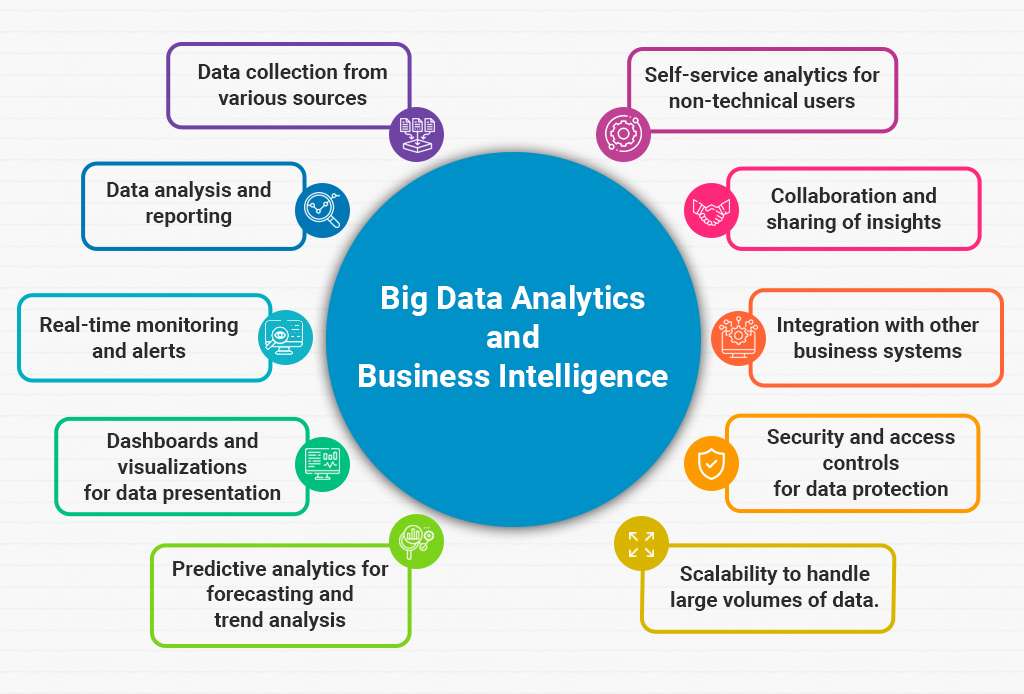In today’s data-driven business world, big data analytics and business intelligence have become essential tools for companies looking to gain a competitive edge. These powerful tools allow businesses to unlock valuable insights from their data, providing a deeper understanding of their customers, products, and operations. By leveraging the insights provided by big data analytics and business intelligence, companies can make more informed decisions that drive growth and innovation.
In this blog, we will explore how big data analytics and business intelligence can be used to unlock insights and drive success for businesses of all sizes.
By combining big data analytics and business intelligence, companies can gain a deeper understanding of their customers, products, and operations. This can lead to a variety of benefits, including:
Improved Decision Making
Real-time data and insights are critical for making informed decisions that drive business growth and success. By leveraging big data analytics and business intelligence tools, businesses can quickly gather and analyze data from multiple sources, adapt to changes in the market, and improve the customer experience. This results in faster and more accurate decision-making, ultimately leading to greater confidence and success for business.
Here are some examples of popular business intelligence tools:
Tableau: A data visualization tool for creating interactive dashboards and reports.
Microsoft Power BI: A user-friendly cloud-based business analytics service for creating interactive visualizations and business intelligence capabilities.
QlikView: A business intelligence platform for data discovery and visualization to make informed decisions.
SAP BusinessObjects: A suite of business intelligence and reporting tools for gaining insights into operations, finances, and customers.
IBM Cognos Analytics: A business intelligence platform for reporting, dashboarding, and data visualization to improve decision-making.
Enhanced Customer Experience
Analyzing customer data is an essential aspect of business intelligence, helping companies gain insights into their customers’ behavior and preferences. By understanding what drives customer satisfaction and loyalty, businesses can improve their products and services, resulting in an enhanced customer experience.
Business intelligence tools, such as customer profiling, segmentation, and analysis, enable businesses to collect and analyze customer data from various sources, including social media, website analytics, and customer surveys. This data can be used to gain a deeper understanding of customer behavior and preferences, such as their purchase history, demographic information, and communication preferences.

Increased Operational Efficiency
Analyzing operational data is a key component of business intelligence, helping companies identify inefficiencies and opportunities for improvement. By gaining insights into their operations, businesses can optimize processes, reduce costs, and increase productivity.
Business intelligence tools allow businesses to collect and analyze operational data from various sources, including inventory management systems, production lines, and supply chain processes. By analyzing this data, businesses can identify areas where processes can be streamlined or improved, such as reducing the time it takes to complete a task or identifying bottlenecks in the production line.
For example, a manufacturing company can analyze data on their production line to identify areas where efficiency can be improved. By identifying bottlenecks or areas of inefficiency, the company can make changes to optimize the production process, reducing costs and increasing productivity.
Better Risk Management
Analyzing historical data through business intelligence tools enables businesses to identify potential risks and take preventive measures to mitigate them. By gaining insights into past events and patterns, businesses can improve risk management and minimize the impact of potential risks on business.
For example, a financial institution can use historical data to identify patterns of fraudulent transactions, allowing them to develop strategies to prevent and mitigate future fraud. Similarly, a manufacturing company can analyze past production data to identify potential equipment failures or supply chain disruptions, allowing them to take preventive measures to avoid production downtime and loss of revenue.
New Revenue Opportunities
Business intelligence tools allow businesses to collect and analyze customer data from various sources, such as social media, website analytics, and customer surveys. By analyzing this data, businesses can identify patterns and trends that indicate customer needs and preferences, such as new product features or service offerings.
For example, a software company can analyze customer data to identify the most commonly used features of their software, and use that information to develop new features that meet customer needs. Similarly, a retail company can analyze customer data to identify popular product categories and trends, and use that information to develop new products that align with customer preferences.
Business intelligence tools can also provide real-time monitoring of customer data, allowing businesses to quickly identify and respond to emerging trends and opportunities. This can help businesses stay ahead of the competition and capitalize on new revenue opportunities.
How can Artificial Intelligence Change the future of Software Development?
Conclusion
Big data analytics and business intelligence tools can drive growth and innovation by providing businesses with access to real-time data and insights. This allows for faster and more informed decision-making, improved operational efficiency, and identification of new revenue opportunities through the analysis of customer data.
Additionally, these tools enable businesses to identify and mitigate potential risks through historical data analysis, which can ultimately help them stay ahead of the competition and succeed in a rapidly changing market. Investing in big data analytics and business intelligence tools is a key strategy for businesses looking to thrive in today’s digital landscape.




